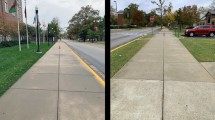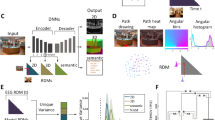Abstract
The subjective visual space perceived by humans does not reflect a simple transformation of objective physical space; rather, perceived space has an idiosyncratic relationship with the real world. To date, there is no consensus about either the genesis of perceived visual space or the implications of its peculiar characteristics for visually guided behavior. Here we used laser range scanning to measure the actual distances from the image plane of all unoccluded points in a series of natural scenes. We then asked whether the differences between real and apparent distances could be explained by the statistical relationship of scene geometry and the observer. We were able to predict perceived distances in a variety of circumstances from the probability distribution of physical distances. This finding lends support to the idea that the characteristics of human visual space are determined probabilistically.
This is a preview of subscription content, access via your institution
Access options
Subscribe to this journal
Receive 12 print issues and online access
$209.00 per year
only $17.42 per issue
Buy this article
- Purchase on Springer Link
- Instant access to full article PDF
Prices may be subject to local taxes which are calculated during checkout








Similar content being viewed by others
References
Hershenson, M. Visual Space Perception: a Primer (MIT Press, Cambridge, Massachusetts, 1999).
Gillam, B. The perception of spatial layout from static optical information. in Perception of Space and Motion (eds. Epstein, W. & Rogers, S.) 23–67 (Academic, New York, 1995).
Sedgwick, H.A. Space perception. in Handbook of Perception and Human Performance Vol. 1 (eds. Boff, K.R., Kaufman, L. & Thomas, J. P.) 21.1–21.57 (Wiley, Toronto, 1986).
Loomis, J.M., Da Silva, J.A., Philbeck, J.W. & Fukusima, S.S. Visual perception of location and distance. Curr. Dir. Psych. Sci. 5, 72–77 (1996).
Gogel, W.C. Equidistance tendency and its consequences. Psychol. Bull. 64, 153–163 (1965).
Owens, D.A. & Leibowitz, H.W. Oculomotor adjustments in darkness and the specific distance tendency. Percept. Psychophys. 20, 2–9 (1976).
Epstein, W. & Landauer, A.A. Size and distance judgments under reduced conditions of viewing. Percept. Psychophys. 6, 269–272 (1969).
Gogel, W.C. & Tietz, J.D. A comparison of oculomotor and motion parallax cues of egocentric distance. Vis. Res. 19, 1161–1170 (1979).
Morrison, J.D. & Whiteside, T.C.D. Binocular cues in the perception of distance to a point source of light. Perception 13, 555–566 (1984).
Foley, J.M. Binocular distance perception: egocentric distance tasks. J. Exp. Psychol. Hum. Percept. Perform. 11, 133–149 (1985).
Philbeck, J.W. & Loomis, J.M. Comparison of two indicators of perceived egocentric distance under full-cue and reduced-cue conditions. J. Exp. Psychol. Hum. Percept. Perform. 23, 72–85 (1997).
Wallach, H. & O'Leary, A. Slope of regard as a distance cue. Percept. Psychophys. 31, 145–148 (1982).
Ooi, T.L., Wu, B. & He, Z.J. Distance determined by the angular declination below the horizon. Nature 414, 197–200 (2001).
Sinai, M.J., Ooi, T.L. & He, Z.J. Terrain influences the accurate judgment of distance. Nature 395, 497–500 (1998).
Meng, J.C. & Sedgwick, H.A. Distance perception mediated through nested contact relations among surfaces. Percept. Psychophys. 63, 1–15 (2001).
Knill, D.C. & Richards, W. Perception as Bayesian Inference (Cambridge Univ. Press, Cambridge, 1996).
Purves, D. & Lotto, B. Why We See What We Do: an Empirical Theory of Vision (Sinauer, Sunderland, Massachusetts, 2003).
Kersten, D. High-level vision as statistical inference. in The New Cognitive Neurosciences. 2nd edn. (ed. Gazzaniga, M.S.) 353–363 (MIT Press, Cambridge, Massachusetts, 1999).
Geisler, W.S. & Kersten, D. Illusions, perception and Bayes. Nat. Neurosci. 5, 508–510 (2002).
Belhumeur, P.N. A Bayesian approach to binocular stereopsis. Intl. J. Comp. Vision 19, 237–260 (1996).
Bloj, M.G., Kersten, D. & Hurlbert, A.C. Perception of three-dimensional shape influences colour perception through mutual illumination. Nature 402, 877–879 (1999).
Weiss, Y., Simoncelli, E. & Adelson, E.H. Motion illusions as optimal percepts. Nat. Neurosci. 5, 598–604 (2002).
Geisler, W.S., Perry, J.S., Super, B.J. & Gallogly, D.P. Edge co-occurrence in natural images predicts contour grouping performance. Vis. Res. 41, 711–724 (2001).
Mumford, D. & Gidas, B. Stochastic models for generic images. Q. J. Appl. Math. 59, 85–111 (2001).
Lee, A.B., Mumford, D. & Huang, J. Occlusion models for natural images: a statistical study of a scale-invariant dead leaves model. Int. J. Comput. Vision 41, 35–59 (2001).
Luneberg, R.K. Mathematical Analysis of Binocular Vision (Princeton Univ. Press, Princeton, New Jersey, 1947).
Indow, T. A critical review of Luneburg's model with regard to global structure of visual space. Psychol. Rev. 98, 430–453 (1991).
Wagner, M. The metric of visual space. Percept. Psychophys. 38, 483–495 (1985).
Todd, J.T., Oomes, A.H.J., Koenderink, J.J. & Kappers, A.M.L. On the affine structure of perceptual space. Psychol. Sci. 12, 191–196 (2001).
Gibson, J.J. The Perception of the Visual World (Houghton Mifflin, Boston, 1950).
Simoncelli, E.P. & Olshausen, B.A. Natural image statistics and neural representation. Annu. Rev. Neurosci. 24, 1193–1216 (2001).
Olshausen, B.A. & Field, D.J. Emergence of simple-cell receptive field properties by learning a sparse code for natural images. Nature 381, 607–609 (1996).
Vinje, W.E. & Gallant, J.L. Sparse coding and decorrelation in primary cortex during natural vision. Science 287, 1273–1276 (2000).
Sigman, M., Cecchi, G.A., Gilbert, C.D. & Magnasco, M.O. On a common circle: natural scenes and Gestalt rules. Proc. Natl. Acad. Sci. USA 98, 1935–1940 (2001).
Howe, C.Q. & Purves, D. The statistics of range images can explain the anomalous perception of length. Proc. Natl. Acad. Sci. USA 99, 13184–13188 (2002).
Huang, J., Lee, A.B. & Mumford, D. Statistics of range images. Proc. IEEE Conf. CVPR 1, 324–331 (2000).
Brainard, D.H. & Freeman, W.T. Bayesian color constancy. J. Opt. Soc. Am. A 14, 1393–1411 (1997).
Acknowledgements
We thank C. Howe, F. Long, S. Nundy, D. Schwartz and J. Voyvodic for useful comments, and M. Williams for help with the art. This project was supported by the National Institutes of Health and the Geller endowment.
Author information
Authors and Affiliations
Corresponding author
Ethics declarations
Competing interests
The authors declare no competing financial interests.
Rights and permissions
About this article
Cite this article
Yang, Z., Purves, D. A statistical explanation of visual space. Nat Neurosci 6, 632–640 (2003). https://doi.org/10.1038/nn1059
Received:
Accepted:
Published:
Issue Date:
DOI: https://doi.org/10.1038/nn1059
This article is cited by
-
The role of action intentionality and effector in the subjective expansion of temporal duration after saccadic eye movements
Scientific Reports (2020)
-
Neuronal Firing Rate As Code Length: a Hypothesis
Computational Brain & Behavior (2020)
-
Optimality and heuristics in perceptual neuroscience
Nature Neuroscience (2019)
-
The effect of image position on the Independent Components of natural binocular images
Scientific Reports (2018)
-
The Active Side of Stereopsis: Fixation Strategy and Adaptation to Natural Environments
Scientific Reports (2017)



